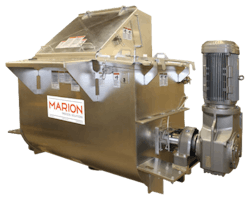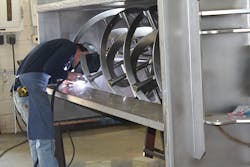Customized mixers: A solution for your industrial needs

Your industrial mixer will likely be with you for 20-plus years, so it is important to make a choice that will serve your production line long-term. If you’ve come from an industrial planning background, or if it has been a while since you investigated buying a new mixer, the options may not be obvious, especially when you are trying to project decades into the future. Fortunately, the right planning — coupled with a smart investment up front — will save you in the long run by purchasing a production mixer that is specifically designed for your company’s needs.
Among the considerations in choosing a mixer:
- Feeders into and out of the machine.
- Composition of the materials being mixed: viscosity, density and granularity of materials.
- Batch versus continuous mixing.
- Multi-purpose or dedicated production lines; whether you’ll be mixing different recipes and cleaning the machine frequently between batches.
- Sanitation of the machines — manual or automated cleaning, frequency and level of sterility needed.
- Impact of dust or particles escaping or leaking. Is it merely an inconvenience or will you be handling pharmaceuticals, explosive or other potentially harmful materials?
- Variability of materials over time; whether you are in an industry that doesn’t change much (coffee, for example), or one where new compounds are often being invented and improved (processed foods or pharmaceuticals).
- Heating or cooling needed during mixing.
- Growth of your organization and increases in production.
- Quality needs over time, and how much regular wear and tear is likely to affect the homogeneity of the mixes.
All of the major manufacturers have mixers that will work for most applications. The question becomes how to maximize the use of the machine and reduce your total cost of ownership by limiting wasted time cleaning, loss of materials due to quality issues and repair and parts replacement spend.
Three benefits of a custom mixer
The right custom mixer will provide you with a solution that addresses three major issues when it comes to your mixing needs:
Sanitation: Depending on the application, cleanability is a major concern to prevent carryover and/or avoid contamination.
Materials Handling: Precise measurement, quality checks and appropriate mixing for the viscosity and granularity of the raw materials.
Durability: Accelerated wear and tear, short and long-term maintenance requirements and the potential for diminishing quality are all results of not having customized your mixer appropriately from the outset.
While this article won’t go into every option available for every application, it will give you an overview of what you should be looking for in each of these three areas, with some examples of what can go wrong or incur extra costs.
Sanitation
Sanitation touches a wide range of areas, from the ease of manual cleaning to dust prevention. For many applications, hygienic design is so important that the USDA and FDA look to 3-A for the development of standards and accepted practices to allow manufacturers and their equipment to become authorized, in order to easily determine that a machine meets the standards required for clean and sterile food and pharmaceutical production.
If you are working in an environment where there’s no room for error when it comes to the cleanliness of your mixers, choose a 3-A authorized mixer, not a “compliant” or “compatible” mixer. To date, Marion Process Solutions is the only 3-A authorized manufacturer of horizontal mixers.
Cleanliness and customization: what makes the difference
A thorough assessment of your sanitation requirements will determine the customized options you should be considering. Perishables, such as milk powders, require pristine and frequent sanitation to prevent contamination. In pharmaceuticals, even a tiny trace of carry-over can have tragic results. Similarly, poorly sealed mixers can result in rooms coated with powders. While dust is an expense and inconvenience for foods and building materials, it can also be a health hazard for employees working in the production space.
Inside, outside and all around
Customizing your mixer for sanitation comes down to a few major areas of focus. While overall hygienic design is of paramount importance, different options or accessories can help to address how the mixer is cleaned, how often it is cleaned and how effective and efficient the process is.
Clean-in-place and rinse-in-place options allow self-cleaning of the inside of mixers and can be customized depending on the materials and whether some of them need to soak in detergent or solvent as part of the cleaning process. Within the self-cleaning category, different types of cleaning automation may be installed, depending on the manufacturer.
For manual cleaning, the accessibility and ergonomics of the doors and trough area is important for custodial work. A variety of options allow removal of different parts, such as the seals, gaskets, spray bars and discharge valves. Having removable parts can speed up the cleaning as well, particularly if it takes time to sanitize or dry the parts separately. Some production facilities keep spares on hand, to further reduce downtime related to cleaning on their production lines.
Sanitation on the production floor (i.e. the area around the mixer) is another focal point when it comes to manufacturing efficiency, as well as reducing cleaning costs. Anyone who has toured different facilities has seen production floors dusted with flour or other similar materials because of poorly fitting door seals or worn out gaskets that are the wrong material, haven’t been properly maintained or have been removed altogether. Anywhere that leaks occur can be a source of health or compliance problems, so it’s worthwhile to invest in customized gaskets, seals, doors and dust collection vents.
Material handling
Material handling sounds so fundamental that it would make sense to assume that every mixer does an excellent job of this. Yet, because each application is different, it’s important to carefully configure the mixer for differences and take into consideration granularity and density, batch versus continuous mixing and the feeds into and out of the mixer. Many manufacturers have a limitation or preference for specific types of geometries and agitators, which are not ideal for all types of applications.
The most important customizations for material handling are the feeds into and out of the mixer, and the agitator of the mixer.
Agitators vary in their abilities to handle different sizes, shapes, densities and potential viscosities of materials. Paddle agitators provide a gentler blending motion, while ribbons are needed to introduce shear or scrubbing action into the mix. It’s also possible to use a hybrid model for some applications, and to add a chopper in applications in which materials tend to agglomerate, require dispersion or size reduction.
The correct input and output customizations provide consistency in the quality of the mixtures, as well as reduce waste. On the input, mixers can include options such as injector manifolds for flavoring, and load cells and surge hoppers to keep the right inflow of materials for a perfect mix. For the outflow, discharge valves are available in a huge range of configurations: flush hinged contour valves, sanitary contour slide valves, knife gate valves, butterfly valves, ball and spherical disc valves, orifice slide valves, flush plug valves, iris valves, 3-A sanitary paddle valves and roller slide gate valves. The proper customization is determined by the next steps along the way in the manufacturing process, as well as the viscosity of the materials and the frequency and methodology for cleaning the discharge valve.
Finally, some mixtures require heating or cooling and most manufacturers offer a variety of jackets that can be designed to provide the optimal temperature for the task at hand.
Durability
Purchasing a new mixer is much more than a single point-in-time decision. An industrial mixer will be your workhorse for many years into the future, no matter who you buy from. So, the question becomes whether maintenance and repair become expensive over time, or if you need to accept that, as the machine ages, the performance could deteriorate. Customizable solutions provide a variety of protections against wear, including replaceable parts for those components of the mixer that are most likely to wear out within its lifetime.
In fact, while agitator configuration is determined by the type of material you are processing, the construction of the agitator is customized for longer-term durability. Welded construction is easier to clean, but can’t be replaced, whereas bolted blades can be replaced in applications where abrasive materials cause rapid wear. Some configurations even combine welded with bolted blades.
Similarly, while we covered gaskets and seals in the section on sanitation, these are also the most sensitive parts when it comes to erosion of the surfaces and quality deterioration. Because seals and gaskets are needed to keep the areas clean, worn-out parts will result in mess and contamination. For manufacturers where the only real implication is dusting (for example with foods) often one finds that the operators remove gaskets when the doors stop closing properly, because it becomes so much of a bother. While this allows the doors to fully close, it also causes leakage of materials, which has quality implications, as well. It’s best to find a solution with gaskets and seals that can be replaced every few years or more frequently, without major maintenance or downtime incurred.
Another common problem is accidentally running the machines without making sure there is ample air supply to the mainshaft and chopper seals. Lack of, or insufficient air, in the best case, is faster wear on the seals, but frequently it can cause catastrophic failure to key components. A simple solution to this problem is highly visible air supply manifolds at eye level, so that the operator can verify the air supply situation and make any adjustments before the issue causes any damage.
Conclusion
While it may seem that all mixers are similar, there are many options that set them apart from one another. As you evaluate your options, sanitation, safety, wasted materials and ongoing maintenance costs are factors that must be considered, and taking shortcuts for budgetary reasons now probably will cost you and your company significantly more over the life of the mixer.
Erik Boyer is the national sales director for Marion Process Solutions. Founded in 1938, Marion Process Solutions is dedicated to delivering custom-manufactured processing solutions to companies in the food, nutraceutical, cannabis, mineral, plastic, chemical and biomass industries. For even more information on customizing your mixer, check out our “Mixer Matters” blogs at blog.marionsolutions.com.

